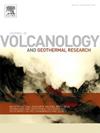Contrasting magmatic structures and tectonic controls from integrated gravity and magnetic data in the Bromo–Tengger–Semeru complex and the Lamongan Volcanic Field, East Java, Indonesia
IF 2.3
3区 地球科学
Q2 GEOSCIENCES, MULTIDISCIPLINARY
Journal of Volcanology and Geothermal Research
Pub Date : 2025-09-24
DOI:10.1016/j.jvolgeores.2025.108455
引用次数: 0
Abstract
This study aims to clarify how contrasting tectonic regimes influence magma storage, connectivity, and emplacement in spatially adjacent volcanic systems within a single arc segment in East Java, Indonesia. We focus on the polygenetic Bromo–Tengger–Semeru (BTS) complex and the Lamongan Monogenetic Volcanic Field (LMVF), employing integrated gravity and magnetic approaches including Bouguer anomaly modeling, 3D Euler and 2D Werner deconvolution, constrained gravity inversion, and magnetic edge detection. A vertically extensive, lens-shaped high-density body is imaged beneath BTS between 5 and 20 km depth, with indications of lateral connectivity between Semeru and Bromo aligned along N-S compressional structures. In contrast, LMVF shows only shallow, dyke-like intrusions (<2.5 km) aligned with NW–SE and NE–SW faults, spatially correlated with maar lakes and cinder cones. These findings support a model in which compressional tectonics in BTS promote deep, laterally connected magma reservoirs, while extensional faulting in LMVF facilitates shallow, structurally guided intrusions. This comparative analysis highlights the role of tectonic segmentation in shaping magmatic structure and provides a replicable framework for integrated geophysical analysis of arc volcanism.
印度尼西亚东爪哇bromo - tenger - semuu杂岩和拉蒙干火山田重磁综合资料对比岩浆构造与构造控制
本研究旨在阐明在印度尼西亚东爪哇的一个弧段内,不同构造制度如何影响空间上相邻火山系统的岩浆储存、连通性和侵位。以多成因bromo - tenger - sememeru杂岩(BTS)和拉蒙干单成因火山场(LMVF)为研究对象,采用综合重磁方法,包括布格异常建模、三维欧拉和二维Werner反褶积、约束重力反演和磁边缘检测等。在BTS下方5 - 20km深度处成像了一个垂直扩展的透镜状高密度体,显示了sememeru和Bromo之间沿N-S挤压构造的横向连通性。相比之下,LMVF只显示出浅的岩脉状侵入体(2.5 km),与NW-SE和NE-SW断裂排列,在空间上与maar湖和cinder锥相关。这些发现支持了一个模型,即BTS的挤压构造促进了深部、横向连接的岩浆储层,而LMVF的伸展断裂促进了浅层、构造导向的侵入。这种对比分析突出了构造分段在岩浆构造形成中的作用,为弧火山作用的综合地球物理分析提供了可复制的框架。
本文章由计算机程序翻译,如有差异,请以英文原文为准。
求助全文
约1分钟内获得全文
求助全文
来源期刊
CiteScore
5.90
自引率
13.80%
发文量
183
审稿时长
19.7 weeks
期刊介绍:
An international research journal with focus on volcanic and geothermal processes and their impact on the environment and society.
Submission of papers covering the following aspects of volcanology and geothermal research are encouraged:
(1) Geological aspects of volcanic systems: volcano stratigraphy, structure and tectonic influence; eruptive history; evolution of volcanic landforms; eruption style and progress; dispersal patterns of lava and ash; analysis of real-time eruption observations.
(2) Geochemical and petrological aspects of volcanic rocks: magma genesis and evolution; crystallization; volatile compositions, solubility, and degassing; volcanic petrography and textural analysis.
(3) Hydrology, geochemistry and measurement of volcanic and hydrothermal fluids: volcanic gas emissions; fumaroles and springs; crater lakes; hydrothermal mineralization.
(4) Geophysical aspects of volcanic systems: physical properties of volcanic rocks and magmas; heat flow studies; volcano seismology, geodesy and remote sensing.
(5) Computational modeling and experimental simulation of magmatic and hydrothermal processes: eruption dynamics; magma transport and storage; plume dynamics and ash dispersal; lava flow dynamics; hydrothermal fluid flow; thermodynamics of aqueous fluids and melts.
(6) Volcano hazard and risk research: hazard zonation methodology, development of forecasting tools; assessment techniques for vulnerability and impact.

 求助内容:
求助内容: 应助结果提醒方式:
应助结果提醒方式:


